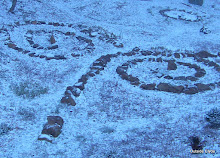What is a weed? In the wild cultivated gardens the answer is slightly different. There are no mulched flower beds here. Instead there are paths through the wildness. The entire garden is one big flower bed.
The idea of an unwanted plant in the flower bed then becomes an impossible notion.
Another approach is needed to define a weed because of the sheer impossibility of removing every unwanted plant that comes up. Even dull or boring plants are not necessarily unwanted. It would not be a good thing, nor would it last long, to weed down to bare ground. Something will always fill the bare space, quickly.
When things get planted a small hole is carved out in the green matrix for the new addition. I have found thirty out of one hundred camassia I planted last fall. Small and grass like, they just may not be standing out where I think I planted most of them. I'll find them when they bloom.
Considering the conditions in a garden that is one giant flower bed, it would not be appropriate for the Great Lawn to be some pristine carpet of turf. I deliberately added more blooming weeds to it. The Great Lawn fits in to the wildness.
The criteria for a weed here is more exacting. The two big offenses are smothering and annoying. Once a plant has been deemed one or both, weeding becomes a single species, garden wide effort to eradicate if from three acres of ground. Everything else is ignored.
For several years I have targeted my main enemy, Clematis virginiana, Blackberry, Elderberry, tree saplings in the utility easement because I have to and Snapweed or Impatiens pallida in the ridge top garden. The Impatiens is nice and the hummingbirds love it, but it wants to be five feet tall and form a monoculture excluding light to everything else. It can live on the perimeter.
I have made so much progress in my clematis eradication efforts, this year two new weeds are being added to the list. Lamium galeobdolon that I have been spraying in the winter while all else is asleep is now being hand weeded to get the remnants the spraying misses.
Cleavers, Galium aparine, is smothering and annoying. I want it out of here. The campaign has begun. It will no longer be ignored.
I'm tempted to weed out this daffodil because the color of the cup looks like a rotten egg yolk. This is my least favorite daffodil.
That's how I weed in the wild cultivated gardens, a few species at a time. Everything else can be ignored. It makes the impossible possible.
Tuesday, April 5, 2016
Subscribe to:
Post Comments (Atom)













9 comments:
Oh, thank you. I went looking for the wild camassia that I saw last year, and wasn't sure what to look for. Now I do, and now I know that I did find it. I'm tempted to move it to a place where I can keep an eye on it (and enjoy it...it's on the side of the hill, and a difficult slope for everyone else to see it). I'm always leery of moving wild things that are happy simply for my own enjoyment.
Got so excited about the camassia I forgot that I wanted to say they call Cleavers, Galium aparine stick tight here in Kentucky. I have it as well. The cats get it stuck to them at times.
And yes, the daffodil does look a little yucky. My mother likes things that color. I know have a selection of asiatic lilies in shades of rotten egg yolk yellow tinged with burgundy spots. I think her eyesight is fading and she can only see very bright colors. Unfortunately my color palette runs to purples and mauve and blues, so the yellow/burgundy stands out like the proverbial sore thumb. But, she likes them, so they stay.
Carol I ordered the camassia bulbs, but I will move wild things to bring them into the garden particularly if they are in danger from bad land management or if there is a huge population to take a few from. The cleavers are an annual so I am hoping if I get them before they set seed, it will be a quickly won battle. Purple, blues, white and yellow would be my favorite color combo.
I can't remember why you have a war on clematis and are eradicating it. Lots of folks like to grow it, climbing on a wire form.....it comes in so many great colors. Should we avoid growing it? Thanks.
Clematis virginiana, Virgin's Bower, the native, and C. terniflora, Sweet Autumn Clematis, its near identical Asian cousin are small, white flowered, late summer bloomers. Both set seed and spread prolifically. Left unchecked in the meadow, it forms a dense carpet that climbs up and sits on top of everything else smothering it. The large flowered, in many colors, hybrid garden clematis vines are not a problem that I know of.
It's the same here with the Japanese honeysuckle that covers everything. It's rampant, strangling everything in its path. There are a few small trees we released that have contorted trunks from being bound up by it. But I bought a honeysuckle for the front porch not long ago, a nice, well-behaved hybrid that will climb, but will not cover the house.
I have those cleavers here and there. They are an annoyance. The past couple of years wild strawberry and creeping charlie have been my nemesis weeds. I keep after them. They are small but mighty. I don't mind that daffodil.
Lisa wild strawberry and Creeping Charlie are wild flowers for me. I would never even attempt to weed them out. Their groundcover stature is what saves them.
Cannot get Creeping Charlie to grow in a pot or any where. Love that daffodil. Wouldn't mind having a bulb or 2.
Post a Comment